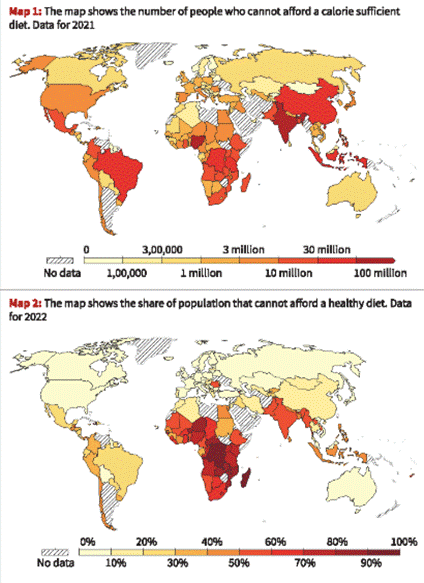Global Context of Nutrition Affordability
- A healthy, nutritious diet is 4x more expensive than a basic calorie-sufficient one.
- 3 billion people globally cannot afford a healthy diet — even if they spent most of their income on food.
- 1.1 billion people (14% of the global population) cannot even afford the most basic energy-sufficient diet (rice/maize only).
Relevance : GS 2(Health , Hunger , Poverty)
Hidden Hunger and Micronutrient Deficiency
- Billions suffer from “hidden hunger” – deficiencies in iron, calcium, Vitamin A, iodine, etc.
- A calorie-sufficient diet (mostly cereals and starches) lacks proteins, essential fats, and micronutrients vital for health.

Economic & Structural Drivers
- The cost of a healthy diet globally averages $3.67/day, unaffordable for low-income populations.
- Subsistence farmers are also counted among the undernourished — if they cannot produce or afford calorie/nutrient-sufficient diets.
- Diet affordability is based on total income minus non–food essential expenditures like housing and transport.
Regional Disparities
- In Sub-Saharan Africa, over 80% of the population cannot afford a healthy diet.
- In India, a healthy diet costs nearly as much as the median income, leaving no room for other expenses.
- In contrast, people in France or Denmark spend just 5–6% of their income on food — showcasing stark inequality.
Food Guidelines vs Reality
- Most countries have Food-Based Dietary Guidelines (FBDGs) recommending a diverse intake from all food groups.
- But these guidelines are economically inaccessible to the poor in many regions.
- Researchers used regionally representative guidelines — not imposing Western models universally.
Policy Implications
- A calorie-sufficient diet might help survival, but fails to ensure health or human potential.
- Economic inequality, food price volatility, and low incomes must be tackled together.
- A sustainable solution must go beyond calorie sufficiency — focusing on nutrition security.
Key Takeaways
- Affordability of food is not just about price, but income and essential non-food needs.
- Three billion people lack the means to eat for long-term health — a global public health crisis.
- Addressing this gap is essential for achieving SDG 2: Zero Hunger and SDG 3: Good Health and Well-Being.
India’s Government Initiatives :
1. Public Distribution System (PDS)
Provides subsidized grains to around 800 million people.
Fulfills calorie needs but lacks nutritional diversity.
2. Pradhan Mantri Garib Kalyan Anna Yojana (PMGKAY)
Initially launched during COVID-19 for free ration distribution.
Now a permanent scheme under NFSA providing free foodgrains to PDS beneficiaries.
3. PM POSHAN (formerly Mid-Day Meal Scheme)
Offers nutritious meals to school children.
Some states include eggs, milk, or fruits.
4. Integrated Child Development Services (ICDS)
Through Anganwadi centres, offers supplementary nutrition, health check-ups, and pre-school education for children (0–6 years) and pregnant/lactating women.
5. National Food Security Act (NFSA), 2013
Provides legal entitlement to 5 kg of foodgrains per person/month for priority households.
Covers 75% of rural and 50% of urban population.
6. POSHAN Abhiyaan (National Nutrition Mission)
Aims to reduce stunting, undernutrition, anaemia, and low birth weight.
Uses technology integration and real-time Poshan Tracker.
7. Anaemia Mukt Bharat (AMB)
Focuses on reducing anaemia in children, adolescents, and women through IFA supplementation, deworming, and fortified foods.
8. Fortification Initiatives
Staples like rice, wheat, oil, milk, and salt fortified with iron, folic acid, Vitamin A & D.
Fortified rice being distributed through PDS, PM POSHAN, and ICDS.





